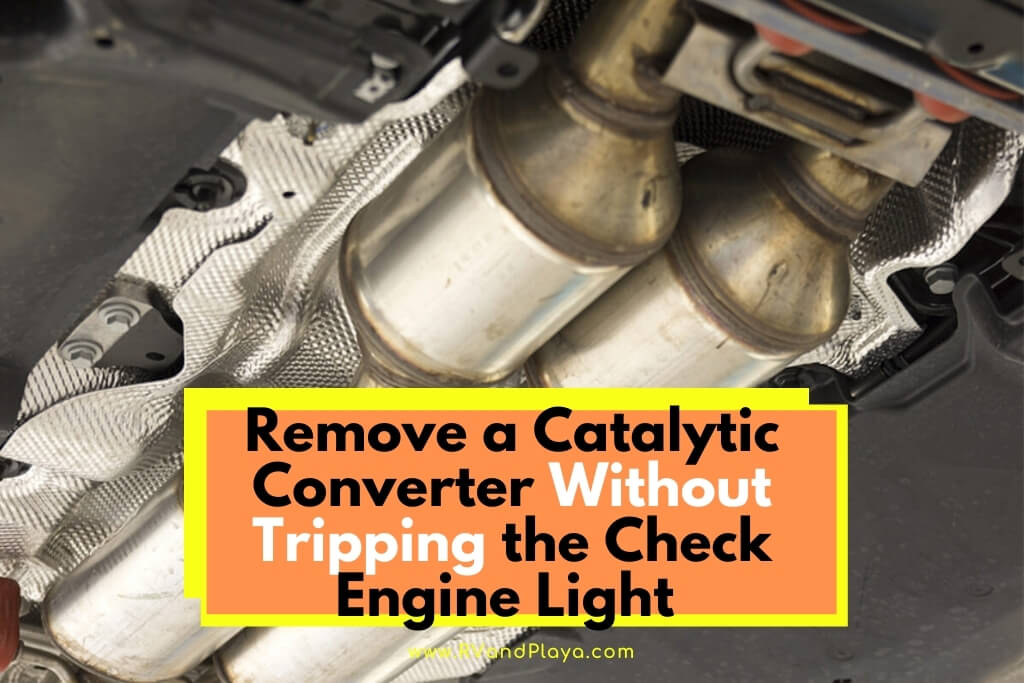Have you ever wondered how to remove a catalytic converter without tripping the check engine light? Well, look no more. We´ve got you covered.
Paying a mechanic to remove and replace a bad catalytic converter can quickly get expensive.
So, how to remove a catalytic converter without tripping the check engine light? You can bypass your car’s catalytic converter without triggering the check engine line using just a few tools and some hardware which included:
• A bypass or test pipe
• An adjustable wrench
• A hydraulic car jack with four stands
• Penetrating fluid
This will improve the engine’s efficiency and put few extra horses under your hood. However, there may be some negative side effects to doing so.
In this guide, we’ll give you a quick rundown on what happens when you remove a car’s catalytic converter, how you can do so at home without the check engine light coming on, and some of the negative consequences of bypassing it.
If you’re ready for some mechanical work, let’s dive in!
Table of Contents
What Even is the Catalytic Converter?
The catalytic converter, or, more commonly, the “cat”, is a standard component of all modern cars’ exhaust systems.
It’s constructed from ceramic and metal in a honeycomb shape, then insulated with rhodium, palladium, gold, and platinum to filter out harmful compounds from your car’s exhaust.
The insulating metals create reduction and oxidation reactions that purify much of your vehicle’s emissions.
Read also: How To Check If Your Catalytic Converter Is Bad (6 Common Problems)
However, blocking a section of your car’s ventilation system makes it harder for your car to push out exhaust.
By removing the catalytic converter, you can actually increase your vehicle’s horsepower, improve gas mileage, lower your engine’s running temperature, and create a generally better-sounding exhaust system.
How to keep the check engine off when removing catalytic converter >> Check out the video below:
Why Does a Check Engine Light Come On If I Remove the Catalytic Converter?
In 1975, the United States government regulated that all cars produced thereon must be built with a catalytic converter. Therefore, if your car’s cat is damaged or removed, the internal computer will read this as a fault and trigger a check engine light.
The downstream O2 sensor will pick up unfiltered air, causing your car’s computer to realize that there’s a problem with the cat.
Read also: Does Seafoam Damage o2 Sensors? (SAFE)
Can I Bypass My Car’s Catalytic Converter and Avoid the Check Engine Light?
Fortunately for car aficionados, you can bypass your car’s catalytic converter without setting off the check engine light.
By using a straight pipe, you’ll be able to skip the cat and allow your vehicle to run more smoothly without it filtering exhaust. However, you may get in trouble with the law if you are caught driving without a cat in the US.
You’ll need the following items to bypass your car’s cat without tripping the check engine light:
- A bypass or test pipe
- An adjustable wrench
- A hydraulic car jack with four stands
- Penetrating fluid
Because they are frowned upon in most of the US, bypass pipes can be difficult to find at local hardware stores. If you want to bypass your car’s catalytic converter, we recommend looking for a pipe online.
How to Install a Bypass Pipe
Before you begin working on your vehicle, be sure to check that you’re on a flat surface such as a level concrete driveway and allow the engine and exhaust system to cool down.
- Lift your vehicle using a hydraulic jack and then lower all four wheels onto jack stands.
- Slide under your vehicle and apply some penetrating fluid to the mounting bolts that hold your catalytic converter in place. Let the fluid sit for at least 15 minutes.
- Remove the wiring harness from the O2 sensor and then remove the sensor completely using an adjustable wrench.
- Loosen the mounting bolts holding the catalytic converter in place, remove it, and place it on the ground.
- Reassemble the system using your new bypass pipe and adjust the bolts until they align with the flanges on the existing pipe.
- Reassemble the oxygen sensor and reattach the wiring harness to reconnect your vehicle’s computer system.
- Lift your vehicle again, remove the jack stands, and lower it back down to the ground
Pros And Cons of Removing the Cat
Taking out your vehicle’s catalytic converter can improve your vehicle overall performance:
- More horses – Without a catalytic converter blocking your exhaust system, your vehicle will not have to work as hard to push out its emissions. It will be able to use that energy to improve your overall horsepower.
- Better sounding engine – If you like the aggressive sound of a sports car’s engine, you’ll love what your engine sounds like after removing the catalytic converter. It’ll sound louder and deeper than before, giving your vehicle a powerful roar.
- Cooler running temperature – Without something blocking the exhaust pipe, your car will be able to expel exhaust more quickly, helping to remove hot fumes from your engine before they have time to heat the internal mechanics.
- Better gas mileage – Less strain on your engine means it doesn’t have to burn as much fuel to expel exhaust. Your car’s engine will run more efficiently and your wallet will appreciate the lighter burden.
Despite the pros, removing your vehicle’s catalytic converter comes with a few setbacks:
You could get in trouble – Depending on where you live, you could face some hefty fines for removing your vehicle’s catalytic converter. Since the EPA regulated that all vehicles made after 1975 be built with a cat, removing this part is technically illegal throughout the country.
There are a few workarounds, though, especially in states like Florida and South Dakota, which don’t have regulations for emissions testing.
- It’s bad for the environment – The EPA originally mandated catalytic converters in an attempt to improve air quality throughout the United States. Removing your vehicle’s cat allows your car to dump toxic unfiltered exhaust fumes into the atmosphere, leading to worse air quality and air pollution.
- You may still have a check engine light – Simply bypassing your vehicle’s catalytic converter doesn’t always do the trick. Car manufacturers know that enthusiasts like the roar and horsepower of a cat-free vehicle, so they’ve come up with ways to further regulate their vehicles. You may need to buy additional hardware to work around your vehicle’s check engine light.
- It’s loud – One man’s pro is another man’s con. Just because you like the roar of a car engine doesn’t mean your neighbors will appreciate it. Be prepared to face the ire of your neighbors every time you start up your engine in the early morning.
- It could increase fuel consumption – For some vehicles, removing the catalytic converter can actually increase fuel consumption. Without an accurate oxygen reading, some vehicles’ internal computers will misread performance and burn more fuel to compensate.
If your catalytic converter is damaged, it’s better to simply replace it than remove it outright.
If you live in the United States, police will quickly catch on to the roar of an engine coming from a small car and levy substantial fines up to $10,000 for tampering with your vehicle’s exhaust system.
Why Might a Check Engine Light Come on After Bypassing the Catalytic Converter?
Because modern car manufacturers know that some enthusiasts remove or bypass their vehicle’s catalytic converter, they’ve begun improving their O2 sensors to be more accurate than before.
If your car´s check engine light is still on after bypassing the cat, it likely means that your sensor isn´t picking up enough oxygen in the exhaust system.
In this case, you’ll have to install an extension spacer to add some more room between the oxygen sensor and the bypass pipe.
This piece of equipment tricks your car’s computer into detecting more oxygen and keep the check engine light off.
Alternatively, you can move the oxygen sensor closer to the frame so that it reads a higher oxygen level than if it were by the pipe.
If you choose this route, you’ll need to block up the hole in the pipe using a bolt with matching threads.
Conclusion
Whether you’re hoping to bypass your vehicle’s catalytic converter to improve horsepower, fuel consumption, and the overall roar of your engine, or because your converter is damaged, you’ll likely have to deal with a flickering check engine light.
You can override the check engine light by installing a bypass pipe and then shifting the oxygen sensor closer to the frame of your vehicle.
Fair warning, though—tampering with your vehicle’s catalytic converter is illegal in much of the United States and can land you with some hefty fines.
Here are some of my favorite tools & equipment´s
Thank you for reading this article. I hope it helps you find the most recent and accurate technical and repair information for your car. Here are some tools that I use as an automotive technician and hope you´ll also find helpful.
There are affiliate links, so if you do decide to use any of them, I´ll earn a small commission. But in all honesty, these are the exact tools that I use and recommend to everyone, even my own family. (NO CRAP)
To see all my of most up-to-date recommendations, check out this resource that I made for you!
References
https://www.epa.gov/sites/default/files/documents/exhsysrepair.pdf
https://www.trenchlesspedia.com/definition/2434/bypass
Recent Posts
How To Check If Your Catalytic Converter Is Bad (6 Common Problems)
Have you ever wondered how to check if your catalytic converter is bad? Look no more. We´ve got you covered. The Catalytic Converter is a vital component of a vehicle because it reduces bad...
Have you ever wondered if seafoam could damage o2 sensors? Your car is very likely one of your most costly investments. Owning, operating, and maintaining a motor vehicle is expensive. You...


